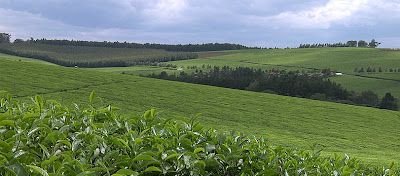Black tea production
Production in Kenya grows by about 2.3 percent a year. In 2010 over 300 000 tonnes of black tea was produced in Kenya, behind India's, the world’s largest black tea producing country, over 1 million tonnes and Sri Lanka's 329 000 tonnes .
China produced 55 000 tonnes of black tea as the balance of production shifts to other teas with stronger market prospects. China is the world's largest producer of teas.
The three largest black tea producing countries, India, Kenya and Sri Lanka, accounted for 70 percent of the world tea production in 2010.
Black tea exports
In Africa production continues to grow while domestic consumption remains small. Exports from Kenya reached 275 000 tonnes in 2010, giving Kenya 32 percent of global exports making Kenya the number 1 expporter of black tea.Approximately 92 percent of all black tea produced in Kenya is exported.
source: www.fao.org
Used to blend other teas
Kenya tea is some of the best quality black tea in the world. In fact, tea from Kenya has won international acclaim for its taste and aroma. Kenyan tea is also the top foreign exchange earner, followed by horticulture, tourism and Kenyan coffee. Most of the exported Kenyan tea is blended with other teas to produce some of the popular blends available in stores today. However, in its purest form, Kenyan tea is gaining recognition in markets across the world because it has been proved to have higher levels of antioxidants compared to teas produced in other parts of the world.
 The quality of black tea depends on the number of top young leaves harvested, the mode of harvesting, and the care with which the green leaves are handled.
The quality of black tea depends on the number of top young leaves harvested, the mode of harvesting, and the care with which the green leaves are handled.
Only the upper young leaves and a bud are handpicked and skillfully processed. Kenyan tea has a distinct bright color and aromatic flavor, thanks to the country's tropical climate and rich volcanic soils.
source: http://www.kenya-information-guide.com/kenya-tea.html
 The quality of black tea depends on the number of top young leaves harvested, the mode of harvesting, and the care with which the green leaves are handled.
The quality of black tea depends on the number of top young leaves harvested, the mode of harvesting, and the care with which the green leaves are handled. Only the upper young leaves and a bud are handpicked and skillfully processed. Kenyan tea has a distinct bright color and aromatic flavor, thanks to the country's tropical climate and rich volcanic soils.
source: http://www.kenya-information-guide.com/kenya-tea.html
Tea Growing Areas
Most Kenya tea is grown in the highlands west of the Rift Valley, at high altitudes between 1500 to 2700 meters. Kericho region, in particular, is where most of the large-scale tea plantations are found. Other tea farming also takes place in the highlands east of the Rift Valley as well as in Central Kenya.View Larger Map
Kenya sees 2011 tea earnings up, output downKenyan tea exports are seen falling to 365 million kg in 2011 after a bumper crop of 399 million kg in 2010, but earnings are expected to rise to 100 billion shillings from 97 billion, the state-run Tea Board of Kenya said on Monday.
The board said in January to August tea output stood at 229.3 million kg, down from 260 million kg in the same period a year earlier, while earnings rose to 72.4 billion shillings from 65 billion shillings in the first eight months of 2010.
"The increase in earnings is attributed to improved demand, as well as a favourable exchange rate," Tea Board of Kenya Managing Director Sicily Kariuki told a news conference.
Kenya is the world's top exporter of black tea and in 2010 tea outpaced horticulture to become the largest source of foreign exchange in east Africa's biggest economy.
source: http://www.businesslive.co.za/africa/africa_markets/2011/09/26/kenya-sees-2011-tea-earnings-up-output-down


No comments:
Post a Comment